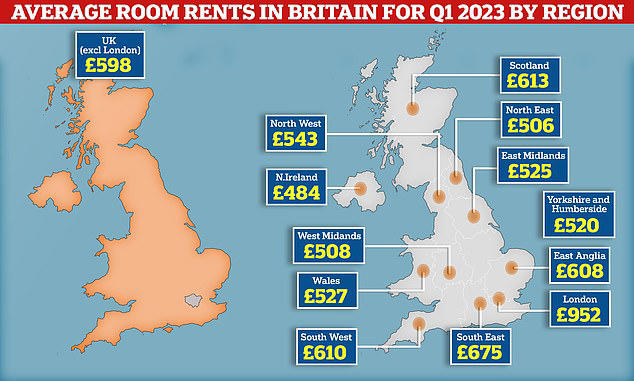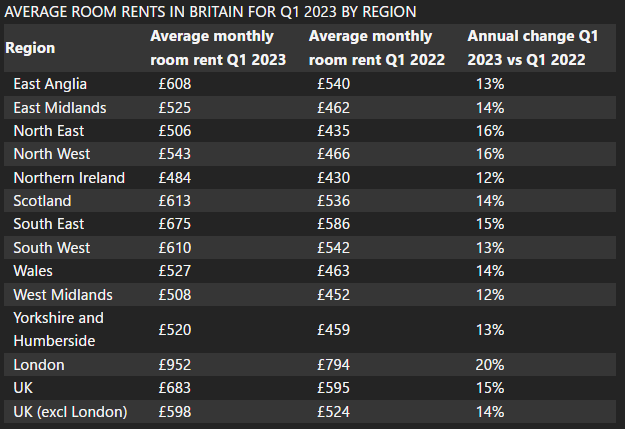Strong rental growth pushed the average monthly rent on a newly let property outside London up to £1,002 pcm in April, passing the £1k pcm mark for the first time.
The data comes from Connells-owned agency chain Hamptons. Passing the £1,000 out-of-London threshold comes less than three years after the average rent for the whole of Britain (so including London) last passed the same milestone in July 2020. Over the last year the average rent outside the capital has risen 7.8%, which puts it 26% higher than on the eve of the Covid pandemic in February 2020.
This annual increase will cost the average tenant an extra £868 a year if they were to move to a new home outside of London. The average rent now exceeds £1,000 pcm in three of the 10 regions outside of London - East of England, South West and South East. Back in early 2013 the average tenant who moved into a new home in regions outside of London paid £677 pcm, £325 pcm less than in April 2023.
Hamptons says average rents have passed four £100 pcm milestones since then, three of which have occurred since Covid. The £900 pcm mark was passed just 21 months ago in August 2021. Across Britain as a whole, rents rose 11.1% year-on-year in April to reach a new high of £1,249 pcm.
This marked the second strongest month for rental growth across the country on record, only to be outpaced by the annual increase of 11.5% recorded in May 2022. Overall, rents across Great Britain have risen 25% since the eve of Covid, costing the average tenant an extra £2,962 each year.
The average rent on a new let in Greater London hit £2,210 pcm in April - 17.2% higher than the same month last year. This meant that April also marked the first time that the average monthly rent in the capital surpassed £2,200 pcm which will cost the average tenant an extra £3,895 a year if they were to move into a new rental home.
Rents in Inner London continued to fuel rental growth. The average monthly rent in Inner London crossed the £3,000 pcm mark for the first time in March (£3,047). In April, the average Inner London rent rose to £3,138 - 24.9%t or £625 pcm higher than the same month last year. Last month, average rents reached new records in seven out of Great Britain’s 11 regions.
Wales, the South West and the North East were the only regions where average rents remained slightly below their peak. Like London, Scotland also saw double-digit rental growth (12.8%) in April for homes where a new tenant moved in.
Shocking supply shortage still the key factor in rental market
Propertymark says the number of new prospective tenants registering per member branch rose slightly to 118 in April. This figure is up from the December low of just 64 and is also 24% higher than April 2022. Stock remains stubbornly low, however, the number of properties available to rent per member branch remained at nine in April. This is the same level of stock as April 2022.
This translated into an average of 16 prospective tenants registering per available property over the same period. Similar to the rise in demand, the mismatch between supply and demand has risen 35% since April 2022. In terms of rent levels, some 50% of responding agents reported rents increasing month-on-month on average at their branch in April. This is down from 75 per cent in April 2022.
Propertymark chief executive Nathan Emerson said, “we are still seeing the demand for property grow but no increase in homes. This means that pressure on rent prices is remaining, whilst new legislation will undoubtedly have a knock on effect, we desperately need more homes for renters.”
A third of tenants spend at least HALF of their take-home pay on housing
Tenants are spending an alarming percentage of their salary on their rent, new data has revealed. While 81% of tenants spend more than 30% of their take home pay on rent, 34% spend at least half of their salary. These tenants are labelled as being 'severely rent burdened', in the research by flat share site SpareRoom.
It is widely accepted that spending more than a third of income on rent leads to being financially overstretched, once household bills are taken into account. It can lead to difficulties in being able to afford other essentials such as food and transport because rent is eating up so much of their disposable income.
Matt Hutchinson, of SpareRoom, said, "when it comes to affordability, the rule of thumb was that rent should be around 30% of your salary. This definition was outdated even pre-pandemic, but in the context of a cost-of-living and housing crisis, a 30% benchmark isn't anywhere close to being realistic. With over 80% of the UK already rent-burdened, and over a third spending over half of their salary on rent, people are really feeling the squeeze, and rising rents will only cause yet more affordability issues for those renting in the UK. It's crucial the Government understands the severity of this situation and starts to help, or this housing crisis will become a housing disaster."
The SpareRoom data shows there has been a considerable shift in what is considered 'affordable' when it comes to rental prices.

© Provided by This Is Money
Women are feeling the strain more than their male counterparts, according to SpareRoom. A total of 85% of women spend more than 30% of their salary on rent each month, compared to 77% of men. More than half, at 59%, of women deem their rent as unaffordable compared to 50% of men.
The data also shows that people in London, the South East and South West England are spending a larger proportion of their take-home pay on rent than other regions. In the capital, 86% of tenants pay more than 30% of their salary on rent, followed by 83% in the South West and 82% in the South East.

Source: SpareRoom
Rents are continuing to increase both in the capital and around Britain, with affordability issues not expected to ease any time soon. The average rent in Britain last month was £1,199 a month, up 1.3 per cent from the previous month's average of £1,184, according to HomeLet. It found that when London is excluded, the average rent was £1,006 a month, up 1.3% from the previous month.
The South East and Scotland both saw the largest monthly variance, experiencing a 2.1% increase from March to April this year, with average rents rising to £1,277 a month and £868 a month respectively. Meanwhile, London rental prices continue to increase, with average rental prices reaching £2,003 a month, 1.2% above the previous month.
Data shows desperate need for more rental properties
Propertymark says the number of new prospective tenants registering per member branch rose slightly to 118 in April. This figure is up from the December low of just 64 and is also 24% higher than April 2022.
Stock remains stubbornly low, however. The number of properties available to rent per member branch remained at nine in April. This is the same level of stock as April 2022. This translated into an average of 16 prospective tenants registering per available property over the same period. Similar to the rise in demand, the mismatch between supply and demand has risen 35% since April 2022.
In terms of rent levels, some 50% of responding agents reported rents increasing month-on-month on average at their branch in April. This is down from 75% in April 2022. Propertymark chief executive Nathan Emerson says, “we are still seeing the demand for property grow but no increase in homes. This means that pressure on rent prices is remaining, whilst new legislation will undoubtedly have a knock on effect, we desperately need more homes for renters.”

